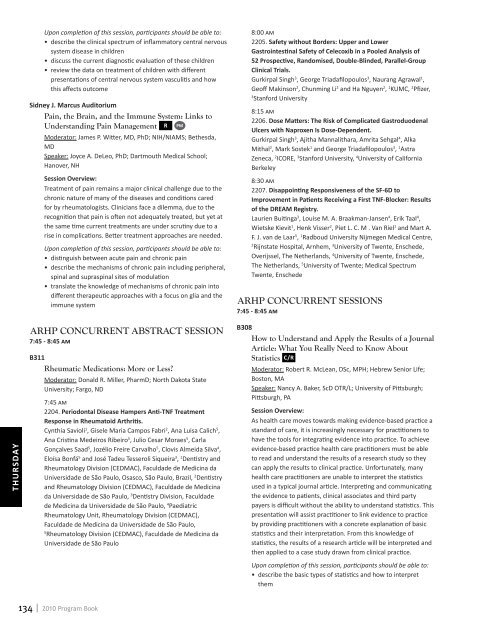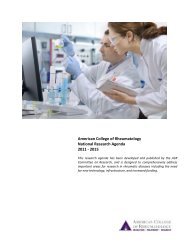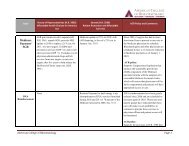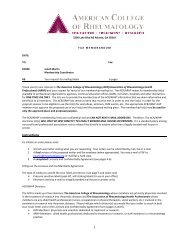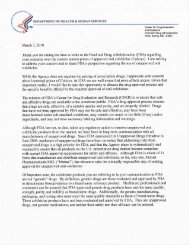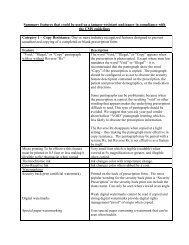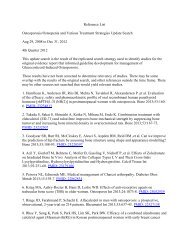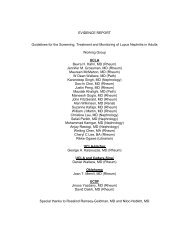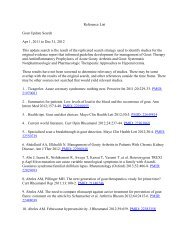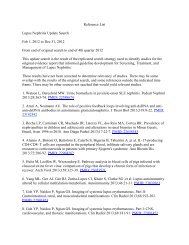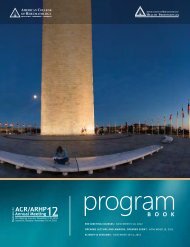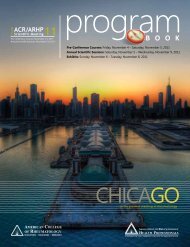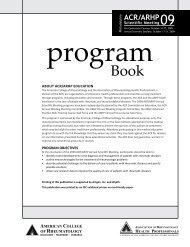B O O K - American College of Rheumatology
B O O K - American College of Rheumatology
B O O K - American College of Rheumatology
Create successful ePaper yourself
Turn your PDF publications into a flip-book with our unique Google optimized e-Paper software.
Upon completion <strong>of</strong> this session, participants should be able to:<br />
• describe the clinical spectrum <strong>of</strong> inflammatory central nervous<br />
system disease in children<br />
• discuss the current diagnostic evaluation <strong>of</strong> these children<br />
• review the data on treatment <strong>of</strong> children with different<br />
presentations <strong>of</strong> central nervous system vasculitis and how<br />
this affects outcome<br />
Sidney J. Marcus Auditorium<br />
Pain, the Brain, and the Immune System: Links to<br />
Understanding Pain Management R PM<br />
Moderator: James P. Witter, MD, PhD; NIH/NIAMS; Bethesda,<br />
MD<br />
Speaker: Joyce A. DeLeo, PhD; Dartmouth Medical School;<br />
Hanover, NH<br />
Session Overview:<br />
Treatment <strong>of</strong> pain remains a major clinical challenge due to the<br />
chronic nature <strong>of</strong> many <strong>of</strong> the diseases and conditions cared<br />
for by rheumatologists. Clinicians face a dilemma, due to the<br />
recognition that pain is <strong>of</strong>ten not adequately treated, but yet at<br />
the same time current treatments are under scrutiny due to a<br />
rise in complications. Better treatment approaches are needed.<br />
Upon completion <strong>of</strong> this session, participants should be able to:<br />
• distinguish between acute pain and chronic pain<br />
• describe the mechanisms <strong>of</strong> chronic pain including peripheral,<br />
spinal and supraspinal sites <strong>of</strong> modulation<br />
• translate the knowledge <strong>of</strong> mechanisms <strong>of</strong> chronic pain into<br />
different therapeutic approaches with a focus on glia and the<br />
immune system<br />
8:00 am<br />
2205. Safety without Borders: Upper and Lower<br />
Gastrointestinal Safety <strong>of</strong> Celecoxib in a Pooled Analysis <strong>of</strong><br />
52 Prospective, Randomised, Double-Blinded, Parallel-Group<br />
Clinical Trials.<br />
Gurkirpal Singh 3 , George Triadafilopoulos 3 , Naurang Agrawal 1 ,<br />
Ge<strong>of</strong>f Makinson 2 , Chunming Li 2 and Ha Nguyen 2 , 1 KUMC, 2 Pfizer,<br />
3<br />
Stanford University<br />
8:15 am<br />
2206. Dose Matters: The Risk <strong>of</strong> Complicated Gastroduodenal<br />
Ulcers with Naproxen Is Dose-Dependent.<br />
Gurkirpal Singh 3 , Ajitha Mannalithara, Amrita Sehgal 4 , Alka<br />
Mithal 2 , Mark Sostek 1 and George Triadafilopoulos 3 , 1 Astra<br />
Zeneca, 2 ICORE, 3 Stanford University, 4 University <strong>of</strong> California<br />
Berkeley<br />
8:30 am<br />
2207. Disappointing Responsiveness <strong>of</strong> the SF-6D to<br />
Improvement in Patients Receiving a First TNF-Blocker: Results<br />
<strong>of</strong> the DREAM Registry.<br />
Laurien Buitinga 3 , Louise M. A. Braakman-Jansen 4 , Erik Taal 4 ,<br />
Wietske Kievit 1 , Henk Visser 2 , Piet L. C. M . Van Riel 1 and Mart A.<br />
F. J. van de Laar 5 , 1 Radboud University Nijmegen Medical Centre,<br />
2<br />
Rijnstate Hospital, Arnhem, 3 University <strong>of</strong> Twente, Enschede,<br />
Overijssel, The Netherlands, 4 University <strong>of</strong> Twente, Enschede,<br />
The Netherlands, 5 University <strong>of</strong> Twente; Medical Spectrum<br />
Twente, Enschede<br />
ARHP Concurrent Sessions<br />
7:45 - 8:45 am<br />
thursday<br />
ARHP Concurrent Abstract Session<br />
7:45 - 8:45 am<br />
B311<br />
Rheumatic Medications: More or Less?<br />
Moderator: Donald R. Miller, PharmD; North Dakota State<br />
University; Fargo, ND<br />
7:45 am<br />
2204. Periodontal Disease Hampers Anti-TNF Treatment<br />
Response in Rheumatoid Arthritis.<br />
Cynthia Savioli 1 , Gisele Maria Campos Fabri 2 , Ana Luisa Calich 5 ,<br />
Ana Cristina Medeiros Ribeiro 5 , Julio Cesar Moraes 5 , Carla<br />
Gonçalves Saad 5 , Jozélio Freire Carvalho 5 , Clovis Almeida Silva 4 ,<br />
Eloísa Bonfá 5 and José Tadeu Tesseroli Siqueira 3 , 1 Dentistry and<br />
<strong>Rheumatology</strong> Division (CEDMAC), Faculdade de Medicina da<br />
Universidade de São Paulo, Osasco, São Paulo, Brazil, 2 Dentistry<br />
and <strong>Rheumatology</strong> Division (CEDMAC), Faculdade de Medicina<br />
da Universidade de São Paulo, 3 Dentistry Division, Faculdade<br />
de Medicina da Universidade de São Paulo, 4 Paediatric<br />
<strong>Rheumatology</strong> Unit, <strong>Rheumatology</strong> Division (CEDMAC),<br />
Faculdade de Medicina da Universidade de São Paulo,<br />
5<br />
<strong>Rheumatology</strong> Division (CEDMAC), Faculdade de Medicina da<br />
Universidade de São Paulo<br />
B308<br />
How to Understand and Apply the Results <strong>of</strong> a Journal<br />
Article: What You Really Need to Know About<br />
Statistics c/r<br />
Moderator: Robert R. McLean, DSc, MPH; Hebrew Senior Life;<br />
Boston, MA<br />
Speaker: Nancy A. Baker, ScD OTR/L; University <strong>of</strong> Pittsburgh;<br />
Pittsburgh, PA<br />
Session Overview:<br />
As health care moves towards making evidence-based practice a<br />
standard <strong>of</strong> care, it is increasingly necessary for practitioners to<br />
have the tools for integrating evidence into practice. To achieve<br />
evidence-based practice health care practitioners must be able<br />
to read and understand the results <strong>of</strong> a research study so they<br />
can apply the results to clinical practice. Unfortunately, many<br />
health care practitioners are unable to interpret the statistics<br />
used in a typical journal article. Interpreting and communicating<br />
the evidence to patients, clinical associates and third party<br />
payers is difficult without the ability to understand statistics. This<br />
presentation will assist practitioner to link evidence to practice<br />
by providing practitioners with a concrete explanation <strong>of</strong> basic<br />
statistics and their interpretation. From this knowledge <strong>of</strong><br />
statistics, the results <strong>of</strong> a research article will be interpreted and<br />
then applied to a case study drawn from clinical practice.<br />
Upon completion <strong>of</strong> this session, participants should be able to:<br />
• describe the basic types <strong>of</strong> statistics and how to interpret<br />
them<br />
134<br />
2010 Program Book


